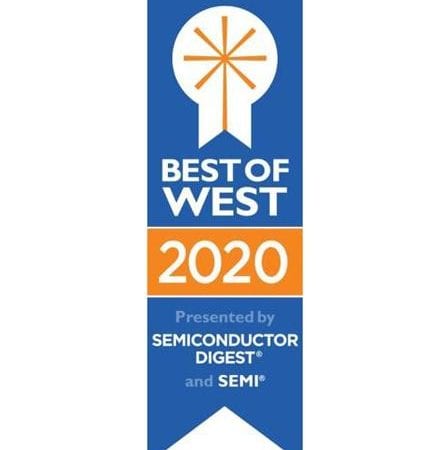High-accuracy FlightSense™ proximity and ranging sensors from STMicroelectronics (NYSE: STM), a global semiconductor leader serving customers across the spectrum of electronics applications, are helping prevent disease transmission in innovative products developed by customers in response to the global pandemic situation.
SEMI Americas and Semiconductor Digest Announce “Best of West” 2020 Finalists: Advanced Energy, Edwards, Flexciton, SPTS
SEMI and Semiconductor Digest today announced finalists for the Best of West award to be presented at the virtual SEMICON West 2020. Presented annually, the Best of West award recognizes innovative new products or services that significantly advance the electronics manufacturing supply chain or a particular manufacturing capability.
“A Prescription for Recovery” Introduced at Virtual SEMICON West News and Views Media Conference
Four briefings to present industry and government forecasts, economic opportunities for microelectronics markets, July 21. Answering these questions and more — tune in to find out: How semiconductor factories globally have been enabled during the pandemic to maintain full production with minimal staff, and how new standards are in development to withstand the next pandemic or crisis
What are the semiconductor equipment companies forecasting for 2H20 and 2021 sales
Is seeing still believing? How technologies and practices enabled by the semiconductorindustry can help to counter malicious disinformation campaigns
Where is U.S. government proposing to invest billions of dollars for semiconductors…
Advanced Energy’s Artesyn Embedded Power to Introduce the iHP Configurable Power Supply at SEMICON West 2020
Developed by its Artesyn Embedded Power product group, iHP is part of a broad portfolio of intelligent, digitally-configurable power supplies that will be introduced at its virtual booth during 2020 SEMICON West, taking place July 20 to 23.
New Technology Speeds Up Organic Data Transfer
Researches are pushing the boundaries of data speed with a brand new type of organic LEDs. An international research team, involving Newcastle University experts, developed visible light communication (VLC) setup capable of a data rate of 2.2Mb/s by employing a new type of organic light-emitting diodes (OLEDs).
N-Doped Carbon Encapsulated Transition Metal Catalysts to Optimize Performance of Zinc-air Batteries
In a report published in NANO, a team of researchers from Sichuan University of Science and Engineering, China have developed N-doped carbon encapsulated transition metal catalysts for oxygen reduction reactions (ORR) and oxygen evolution reactions (OER) to optimize performance of zinc-air batteries.
SVXR Introduces Strategies for Sub-surface Inspection of Advanced Packages at Test Vision Symposium at SEMICON WEST 2020
SVXR, Inc. a pioneer in inspection and metrology technology, will join the Test Vision Symposium at the 50th edition of SEMICON WEST this year.
Siemens Acquires Avatar, Expands EDA Footprint with Innovative Place and Route Technology
Siemens has signed an agreement to acquire Santa Clara, CA-based Avatar Integrated Systems Inc., a leading developer of place and route software for integrated circuit (IC) design. Avatar helps engineers optimize power, performance, and area (PPA) for complex chips with fewer resources.
Microtronic Announces Real-time Macro Defect Monitoring – Within Semiconductor Processing Equipment
Microtronic, maker of high-speed full-wafer macro defect inspection systems and software, has just announced an innovative new way to automatically detect and manage wafer processing defects, beginning at the source – from inside specific types of processing tools.
Graphene-Adsorbate van der Waals Bonding Memory Inspires ‘Smart’ Graphene Sensors
Monolayer graphene, an atomic-layer thick sheet of carbon has found immense applications in diverse fields including chemical sensors, detecting single molecule adsorption events electronically.
